Considered an invasive species and a great addition to freshwater aquariums, Moneywort (Bacopa Monnieri) is also known as Water Hyssop. It also has been traditionally believed to have cognitive and memory-enhancing properties.
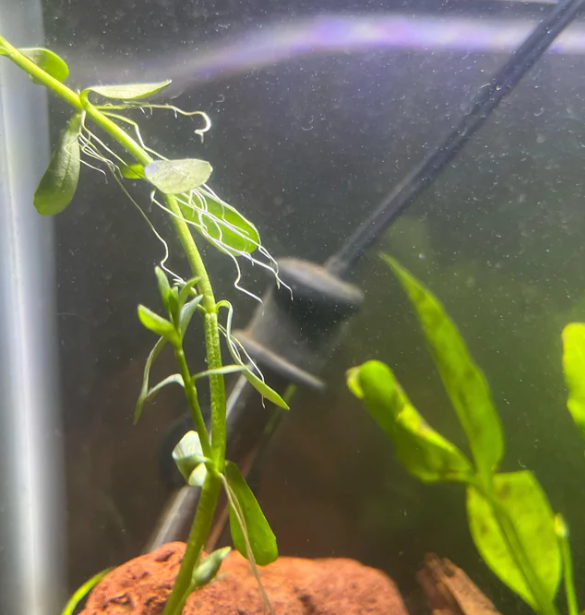
Native to various parts of Asia, including India, Sri Lanka, China, and Taiwan, Moneyworts grow in wetlands like ponds, streams, and marshes. However, it has naturalized itself in North America, Australia, and many other regions around the globe through its popularity in the aquarium trade.
In this article, we’ll discuss details, the care process, and propagation methods for moneywort.
Table of Contents
Moneywort Overview
Moneywort plants were introduced to the aquatic industry for their oxygenation and water filtration capabilities. It absorbs excess nutrients from the water, such as nitrates and phosphates, to reduce pressure on the filtration system.
These species of plants are pretty dense. Moneyworts provide shelter and a hiding place for small fish and invertebrates. It also adds vibrant green contrast to the overall aesthetics of the tank.
Moneywort Quick Stats
| Information Chart | Moneywort |
| Scientific Name: | Bacopa monnieri |
| Family: | Plantaginaceae |
| Care Level: | Easy |
| Plant Size | Up to 12 inches. Trimmable. |
| Growth Rate | Fast in optimal conditions |
| Minimum Tank Size | 10 gallons or more |
| Temperature | 72 to 82F |
| WaterConditions | pH 6.0 to 7.5 Hardness moderate |
| Lighting | 2-3 watts per gallon for 10-12 hours |
What does Moneywort look like?
Moneyworts have long stems with bright green leaves alternating on either side. Their thick and plump leaves withstand the abuse caused by playful or aggressive fish species. Their stems also are pretty sturdy enough to survive fast water flow.
This flowering plant produces white and purple flowers growing from the leaf nodes. But, flowering only happens in the wild or when the tank conditions are met. The leaves typically grow up to an inch in size with the whole plant growing around 2 inches wide.
Types of Moneywort
Apart from the common moneywort that’s mostly discussed in this article, there are a few other species of plants that have similar appearance and characteristics as moneyworts. While they aren’t exactly a variation of the same, they also are commonly referred to as moneyworts in the aquarium trade.
1. Water Hyssop
The common moneywort. It’s a versatile aquatic plant known for its bright green succulent leaves.
2. Creeping Jenny
This is a terrestrial plant that’s frequently used in bog or riparium setups. It has rounded, golden-yellow leaves.
3. Golden Creeping Jenny
This type of moneywort has more vibrant golden leaves. It also is used in riparium setups as a terrestrial plant.
4. Irish Moss
Aka Baby’s Tears, Irish moss is rarely used in aquariums; for them being terrestrial. However, their varying appearance makes them pretty suitable for terrariums.
Natural habitat
Moneyworts are pretty versatile adaptive plants. In aquatic environments, Moneywort can grow in a variety of substrates, including gravels, sand, mud, and even rocks. It can anchor itself to the substrate or grow as a free-floating plant.
In its free-floating form, it’s adapted to sustain high water flow but is seldom found in such waters.
In its partially or completely submerged form, it prefers receiving moderate to high lighting for optimum growth. In floating form, ambient lighting is often sufficient.
Size and Growth Rate of Moneywort
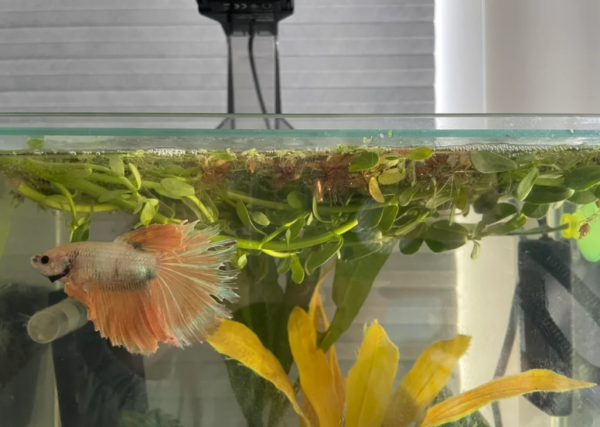
Moneyworts can grow significantly well in artificial waters. If not trimmed, they can even outgrow the tank in both height and width.
How big do Moneyworts get?
In optimum conditions, moneyworts can grow up to 12 inches or more in height. However, aquarists prefer to trim them down to keep them to a manageable size. Depending on your setup, a 6-8 inches height should be adequate.
As for spread or horizontal growth, moneyworts send out runners to cover a very wide space. Which often presents a bushy appearance. The spread can be controlled by pruning.
Moreover, their submerged growth differs slightly from terrestrial growth. Their drier counterpart spreads more and produces flowers.
How fast do Moneyworts grow?
Moneywort has a slower growth rate. Optimally, they grow around an inch in a month. But, lighting, nutrient levels, and water parameters influence their growth rate.
Caring for Moneywort Plant
Moneyworts are pretty hardy plants. Caring for them is easy and doesn’t require any significant setup.
Trimming and Pruning Moneywort
You need a pair of materials to trim and prune moneywort. Sharp aquarium scissors and a bucket to collect plant material are the most important among them. A pair of gloves may also be included in the list.
You have to ensure clean cuts to prevent rotting. Sharpen the scissors before starting the process.
Decide where you want to make the cuts to limit vertical growth. Moneyworts grow pretty conveniently, so they can be cut at any point along the stem.
To create a more bushy appearance, cut the stem just above a leaf node, where the new leaves will sprout. Hold the stem between your fingers and make a clean cut.
Collect the trimmed plant matter in the bucket to either dispose of or propagate them.
The frequency of trimming mostly depends on your preference, but if you’re focusing on a carpeting appearance, trim and prune your moneywort once every two weeks.
Nutritional Requirements for Moneywort
Additional nutritional requirements are almost non-existent for Moneyworts. They thrive on excess nutrients and CO2 available in the water. However, you may subject them to liquid fertilizers to promote growth.
Tank Requirement and Setup
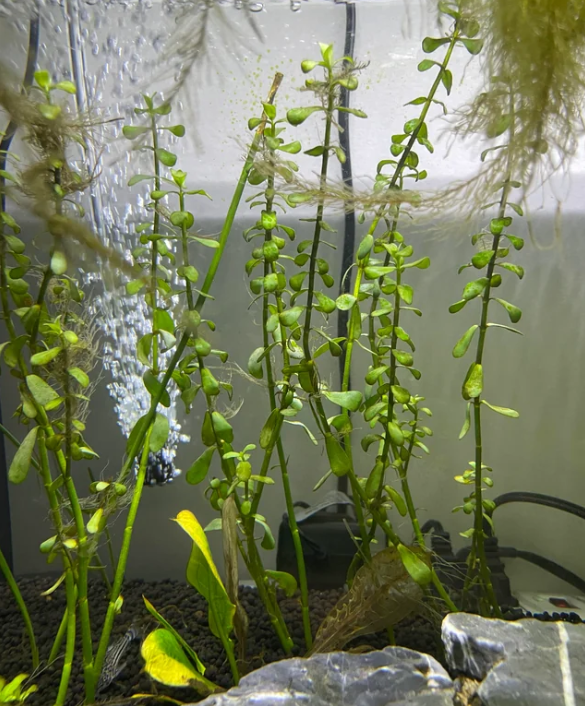
Moneyworts can grow in the wild. There is no reason to think that they need any additional tank requirement to deploy the runners. Neutral freshwater aquariums with optimum water conditions are enough to sustain this beginner-friendly aquarium plant.
1. Moneywort Tank Size and Specifications
Although moneyworts can tolerate significant deviations, here are a few tank parameters that you need to roughly follow.
Tank Size
Moneyworts are only 2-3 inches wide with leaves. Therefore, the argument for a hefty tank only to house a moneywort is invalid.
But, as you may also be keeping other aquatic animals like fish or invertebrates in the tank, it’s advised to keep a pair of moneyworts in a 10-gallon tank with small fish species.
Water Parameters
Moneyworts are quite adaptive and sturdy. Moreover, as discussed, they can tolerate a wide range of water parameters.
Owing to the same, aquarists prefer having it in their aquariums to prioritize the parameter requirements of the fish and not the plant.
Here is a list of the critical parameters that you need to follow:
- pH: 6.0 to 7.5
Keep it as close to neutral as possible. Use RO water to reduce pH. Use crushed corals or commercial pH buffers to increase. - Temperature: 70 to 82 degrees Fahrenheit or 21 to 27 degrees Celsius. If the water is warmer, increase water flow on the surface with a flow generator. Use a heater if it’s too cold.
- Water hardness: 5 to 20 KH. Freshwater aquariums seldom go beyond these limits.
Substrate
Aquarium plant soil, covered with soft sand, is the best choice for moneyworts. But, as expected, any type of substrate is workable with these plants. You can even keep them floating. Revolve your choice of substrate on the fish and not the plant.
You may find it troubling to anchor the plant to substrates. Use superglue or silicon glue to fixate them on the rocks or gravel. You can also use smaller rocks to hold them down.
Filter Type
Again, focus on your fish for the filter choice. The only consideration is that you don’t subject your moneywort plants to a direct flow of water. Despite being quite sturdy, they can be uprooted and harmed.
How much Moneywort in a 10-gallon tank?
You can put at least 2 moneyworts in a 10-gallon tank. If you can keep up with the trimming and pruning process, three moneyworts are also probable.
2. Moneywort Lighting Requirements
Light is the most critical element, second to CO2, for a plant to thrive. While moneyworts can do pretty well in a moderately lit condition, they do best when subjected to 10 to 12 hours of lighting.
Provide them with 2-3 watts of lighting per gallon of water and see them spread their branches and reach over the tank in a few months. Depending on whether the plant is floating or submerged, the light requirements may vary a bit.
The presence of other larger plants may also increase the lighting requirements.
Moreover, wastefully bright light may also cause discomfort to your fish.
3. Fertilizer and CO2 for Moneywort
As mentioned, moneyworts can absorb excess nutrients from the water. In addition to keeping your aquarium healthy, it helps them derive the required macro and micronutrients from the tank.
However, if you have a really good nitrogen-cycled tank, you may use liquid fertilizers that contain nitrogen, phosphorus, potassium, and iron.
Additionally, root tablets installed below the substrate near the plants can be beneficial. Follow the manufacturer’s recommended dosing frequency to keep your overall aquatic environment healthy.
Moneywort can grow without supplemental CO2 injection, but it can promote growth and vibrancy.
4. How to use Moneywort in an aquarium
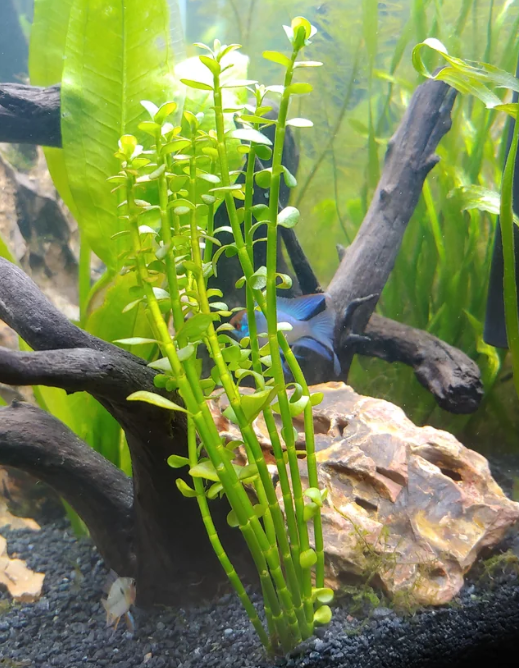
Most fish species shouldn’t have any issues with moneyworts in the tank. As plants with small round leaves, this specimen of aquatic plants is suitable as mid-ground decorations and as a carpeting choice.
Plant them equidistantly and offer them enough space to grow. Allow your small fish species to take moneyworts as cover and explore its branches and leaves. If possible, anchor them to the substrate for better leverage against abusive fish species.
5. Maintenance of Moneywort in a Tank
Here is a checklist of how to maintain moneyworts after they’ve been settled in the tank and are thriving.
- Pruning and Trimming
Trim the plants as per your preference and remove any dead leaves or branches that may jeopardize water quality.
- Algae Growth
Algae growth is pretty substantial on moneywort leaves. Clean them gently during water change and check the nitrate levels of your tank.
- Fish and Invertebrates
Ensure moneyworts aren’t in your fish’s diet. Herbivore fish and certain invertebrates love chomping on plants as treats.
- Water Change
Perform a 10-20% water change every 1-2 weeks to maintain water quality for your fish and moneyworts. Adjust the occurrences as per your tank’s needs.
How to Plant Moneywort
If your moneywort is sourced from a pet store it possibly has a root system growing already. Plant them directly into the soil or dirt in your substrate. You may also keep them floated in nutrient-rich aquariums.
On the other hand, if you’ve collected or received a piece of moneywort stem cut from the main branch, it may take longer for the roots to sprout. You’ll see them barely surviving before suddenly growing like crazy.
You may also use tweezers to plant the moneyworts safely.
How to Propagate Moneywort
Propagation Level – Easy
It’s easy to propagate or “replicate” moneywort plants. The essential materials include:
- A healthy moneywort plant
- Aquarium scissors or pruning scissors
- Substrate (optional)
Propagation Method
- Choose a vibrant, healthy, free-from-disease moneywort plant.
- Ensure that your scissors are sharp and clean. Dull edges can harm the plant.
- Choose a stem that has healthy leaves and has grown long enough. Better, if the leaf nodes have started growing roots.
- Make a clean diagonal cut below the leaf nodes. The cut should leave several leaves on the stem.
- Either plant the stem into the substrate or leave them floating on the water’s surface. Moneywort plants develop roots while floating.
You don’t need to offer any additional nutrition or CO2 to the propagated stems. Leave them as they are and maintain the water parameters.
Tank Mates for Moneywort
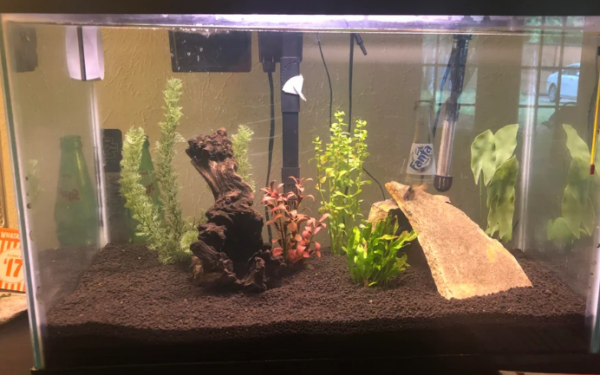
Except for a few exceptions, moneyworts are pretty friendly with other aquatic species and plants.. Here is a compatibility list for moneyworts.
1. Suitable Plants with Moneywort
The adaptive moneyworts don’t compete with any plants. However, it prefers plants with a non-invasive nature and slow growth rate. Let’s look at some plants that require similar water parameters to Moneyworts and can be used for aquascaping.
- Java Fern
- Anubias
- Cryptocoryne
- Amazon Sword
- Dwarf Hairgrass
- Ludwigia
- Hornwort
- Rotala
- Java Moss
- Duckweed
- And many more
2. Unsuitable Plants with Moneywort
Here are some types of plants that aren’t suitable for moneyworts:
- Fast-Growing Weeds: Water Hyacinth (Eichhornia crassipes)
- Highly Aggressive Plants: Hydrilla (Hydrilla verticillata)
- High Light Plants: Red tiger lotus (Nymphaea lotus ‘Red’)
- Plants with Different Water Parameters
- Root Competitors: Vallisneria (Val)
- High-Nutrient Plants: Alternanthera reineckii
- Floating Competitive Plants: Water lettuce (Pistia stratiotes)
- Algae-Prone Plants: Hair algae (Spirogyra spp.)
3. Suitable Fish with Moneywort
Peaceful, non-aggressive, and smaller fish are most well-suited with moneywort plants. Here are a few examples of them:
- Tetras
- Guppies
- Platies
- Corydoras Catfish
- Otocinclus Catfish
- Bristlenose Plecos
- Rasboras
- Dwarf Gouramis
- Swordtails
- Honey Gouramis
- Cherry Shrimp (invertebrate)
- Amano Shrimp (invertebrate)
4. Unsuitable Fish with Moneywort
Some types of fish species are ill-suited with moneyworts. Let’s discuss what they are and why they aren’t suitable.
- Aggressive Cichlids: Oscars, Red Devils, and Jack Dempsey. They may uproot the plants.
- Tiger Barbs: Tiger barbs are known for fin-nipping behavior and may cause damage to the moneyworts.
- African Cichlids: Includes cichlids from Lake Malawi, Lake Tanganyika, and Lake Victoria.
- Goldfish: Especially common goldfish varieties like the Comet or Shubunkin. Given how explorative they are, your moneyworts will never be safe with them.
- Arowanas: These large, active fish need larger space to swim around and the plants may hinder it.
- Bala Sharks: Bala sharks grow large. They also are pretty active swimmers.
Benefits of Having Moneywort in Your Tank
As with most aquatic plants, moneyworts also derive a few benefits for your planted tank.
Aesthetics
Bright green leaves and horizontal growth of moneyworts can give you the liberty to increase the aesthetics of your tank. It can be a great addition to your already beautiful aquascape.
Oxygenation
During the day, moneyworts absorb carbon dioxide and release oxygen to oxygenate the water. It benefits the overall health of tank inhabitants.
Water Filtration
By absorbing and using excess nutrients and trace elements, it helps filter the water. Having moneyworts leads to a more stable aquatic environment.
Algae Control
By absorbing excess nutrients, including nitrate, moneywort controls the growth of algae in your tank.
Are Moneyworts Suitable for your aquarium?
As a beginner-friendly aquatic plant, moneyworts are suitable for every freshwater aquarium. Follow this care guide, trim, and propagate your moneywort plants to have a stable tank supported by the plants and aquatic inhabitants.
Moneywort FAQs
Yes, Moneyworts are great for aquariums. They aren’t toxic. Their leaves aren’t tough. They contribute gracefully to the overall aesthetics.
Yes, Moneyworts, like every plant, need CO2 to survive. However, Moneyworts don’t need additional CO2 to grow.
Moneyworts grow best in medium light. But, they can adapt to the higher lights if you must keep them in that setup.
No related posts.
